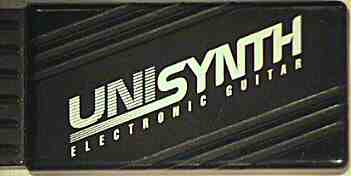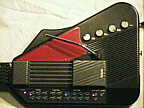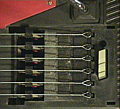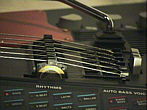
 |
electronic pseudo-guitar with FM sound & rhythms |
This instrument is shaped like a guitar, but has a soft touch sensor field instead of strings on the fret board. 6 very short strings below it can be picked like on a normal electric guitar and there is a lever for pitchbend. Despite I am no guitar player, I easily recognize that any finer guitar play tricks (like letting fingers vibrate on a fret to produce vibrato, or releasing a still vibrating string to let the pitch go down) are ignored by this instrument; possibly this was intended as a beginner's aid to make always perfectly pitched sounds even without the skill of playing precisely.
warning: The rubber fretboard of this instruments dissolved over time into black tar-like goo. Possibly it is a reaction with a glue layer underneath or simply UV light and ozone. So it is unlikely to still find these in playable condition. Likely it is ultra-rare now and will need major modification to make them playable again.
I read on the internet that also a version with MIDI output exists and that it was made by Suzuki; mine has none and on the type label stands a japanese company "Comnics". I thought it was made by Kawasaki.
 |
 |
 |
This is the serial number plate; the thing is made by Comnics and I see no hints to the sales brand. |
 |
 |
This is a close view at the piezo pickup unit; above the grey string mute button you can see the pitch adjustment hole for tuning the instrument. |
Warning:
A very nasty disease (design flaw?) of the Unisynth seems to
be that the foam rubber on the fret board decomposes into a tar- like,
smeary goo over time. Also mine has begun to dissolve at the rims. I am
not sure if this is caused by a chemical reaction between the foam rubber
and an incompatible glue layer underneath, or if external influences cause
this. But I know that at least with latex rubber the most overlooked destructive
long- term influence (besides fatty finger dirt, PVC plasticizers and humidity)
is ozone (and other pollutants) from ordinary room air, which makes latex
smell bitter and crack apart at folded or stretched areas, therefore latex
should be stored best in completely dry and unstressed state in an airtight
container. Although I expect that the Unisynth foam rubber is rather polyurethane,
I think that it suffers of very similar problems, because I yet made only
bad experiences with the life span of polyurethane, which regularly crumbles
apart after few years e.g. at headphone ear pads, loudspeaker box fillings
and clothing elastic bands (here called elasthane).
To fight drcomposition, I recommend to store the Unisynth guitar in
a clean, airtight PE plastic bag out of reach of laser printers, photocopiers
and strong electric motors (because they emit ozone) away from UV radiation
(direct sunlight) at a cool place and without any objects pressing against
the foam rubber. Already given stickiness can be neutralized by powdering
with corn starch or (better) by carefully applying thick silicone oil (sold
e.g. as latex care fluid in sex shops; any other oils destroy latex rubber)
or "Armor All" car cockpit polish with a piece of plastic foil onto
it. Armor All is reported to protect latex well against ozone and
stickiness and even builds up a permanent protective (silicone rubber?)
coating.
hardware detailsrepair tips:The fretboard foam rubber decomposition does not affect the electric (polyester?) contact foils in the fret board, thus the technical components will likely stay fully intact even if the foam deteriorates. It is therefore a very good idea to make a plaster mould of the fret board surface so long it is possible, and then cast a new fret board rubber mat from either non- toxic liquid latex (sold e.g. for mask making in art shops or as body paint in sexshops) or even from ordinary silicone sealant, which is oil and ozone resistant, but fungicides in sealant can be toxic. Nowadays special silicone sold as fishtank glue or theater makeup may be the best solution.After removal of the decomposed foam, the new mat can be mounted e.g. with double sided adhesive tape. A latex mat should be treated with thick silicone oil or Armor All against sticking and ozone attacks. Keep the plaster mould for future use if anything goes wrong. (I didn't replace my fret board mat yet, but it may become necessary in future.) electric fret board problems The fret board of this instruments tends to respond wrongly by a variety of very different defects. To find them it is necessary to understand its working principle. The sensor fret board contains a plastic foil keypad with 6 analogue contact traces those resistance varies depending on which fret of a "string" is pressed. (Each "string" corresponds to 1 resistance sensitive contact.) The black outer fret board coating with the embossed fret/ string pattern consists of a very fragile foam rubber which behaves much like varnished chewing gum and which is firmly glued to the contact foils and the plastic below, therefore NEVER attempt to dismantle this component because you would likely tear it apart. Also the foil cable to the PCB is short and fragile and its traces get easily destroyed by scratches or folds; to remove it from its socket, the upper plastic part of the socket needs to be lifted by hand to unlock the foil bracket. To re-install it later, insert the cable with lifted bracket and than press the bracket down into its former place to re-lock it. If the notes on your fret board are in a wrong order (a section of high notes above very low ones), first check if the pitchbend lever still works; whenever its potentiometer or the PCB traces or solder joints to it got interrupted, the CPU will read a very wrong position value which causes some kind of numeric overflow and though messes up the note order. When the lines to it are repaired, pitchbend should work and the note order should be ok again. If the notes order is correct, but the strings are detuned against each other while the pitchbend lever is in normal position and no frets are touched, first move the lever various times along its full extend to free the pot from possible contact dirt. When the problem persists, adjust the small trimmer pot on the PCB near the pitchbend pot until the relative string tuning sounds ok again. (The trimmer changes the bias value of the pitchbend lever to set its neutral position.) When the relative tuning toggles between ok and wrong, turn the trimmer a little more until the problem vanishes; if it doesn't vanish, then likely the pitchbend pot is bad or its flimsy return mechanism is worn out. When multiple frets of the same "string" on the fret board play the same note while another note is missing, try to adjust the 2nd small trimmer pot (located closer to the fret board). Attention: The setting of this pot is only read by the CPU while it is booting up. During adjustment it is therefore necessary to switch the instrument off and on again each time to make any changes take effect. (This nasty behaviour took me plenty of time to find out.) When also adjusting this pot didn't give the desired results (e. g. because as soon one "string" is adjusted ok, always others get messed up, or when some strings don't react at all), then the foil cable may be scratched at its socket on the PCB. To fix this, first try to lift its socket bracket and move the cable by about 0.5 mm in any direction, close the bracket again and readjust the 2nd trimmer pot. When it had no success, repeat it carefully with motion into other directions. If it still doesn't work, carefully pull the foil cable out of the opened socked and check if socket pins are dirty or bent; if they are ok, look if the foil cable traces were scratched by the pins; if yes, careful cut about 1 mm of the foil cable off with a small scissors to make the unscratched section of the traces touch the socket pins correctly again. (Possibly also the small positioning slits in the cable need to be cut slightly longer to make it fit well into the socket again.) |
Here is some info someone e-mailed me about the MIDI and non- MIDI Unisynth
version:
| Thanks for posting some great info on the UniSynth. I have both
a MIDI and non- MIDI version of this "instrument" and am experiencing the
glue turning to black goo under the body end of the fretboard. I
will have to try some of your fixes, though I am not really in the circuit
bent league that you are.
Both UniSynth's that I have are manufactured by Suzuki (vs. Kawasaki). The MIDI version (XG-1m) only sends MIDI information on channel 1. This includes note/pitch, pitch bend and velocity. The strings have a pretty low- tech but ingenious way of sending velocity information, by way of the springs where the strings attach. This makes the UniSynth touch sensitive, which is pretty neat for the times and the price. As it uses the same layout as the non- MIDI version, there is a space for an internal speaker, but there is none inside. Patch changes can be made with the numeric buttons on the upper bout of the body. I found the MIDI one in a music store in upstate New York (near the Canadian border), in 2001. It had been sitting in the store, unsold, since 1987, when they had ordered it new from Suzuki. It came with the AC adaptor and manual and I got it for US$90 (pretty good compared to the US$275 or $375 they said they were asking for in 1987). I have a version of the one that you have, purchased from eBay. This one came in the original box and included one of the song books that were available for it at the time. I think the one I have is country classics. I am not really a country fan, but I don't recognize any of the "classics" in the songbook. The box graphics include pictures of an 80s couple (think bad hair, shoes, makeup and leg warmers) sitting in the back of a pickup truck playing their UniSynth. The manual for the non- MIDI version also includes additional pictures of a very 1980s woman playing her instrument. The MIDI manual is very dry and to the point. Anyway, I just wanted to fill in some details, if it helps at all. Thanks again for providing suggestions on how to keep my UniSynth alive, after the elements have had their way with it. |
Similar pseudo- guitars like the Unisynth were also made by Casio
as DG-10 and DG-20 (the latter with MIDI).
| removal of these screws voids warranty... | ||
 |
||
|
|